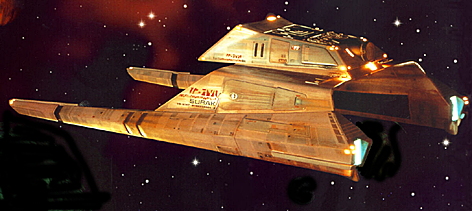Owner: K'pok

This is a small scout-freighter, normally operating with a crew of three or four, though a single person can run it if need be and it is capable of accommodating up to eight. It came to K'pok when her mother and the other two crew members were killed when the ship was struck by a piece of space debris; K'pok managed to nurse it to a landing on the nearest planet, and spent the last of her currency in repairing the main fusion plant which had suffered considerable damage in the accident. She managed to swing a deal with an industrialist on Cordwainer for the deuterium required to refuel the main power plant so that she was capable of full hyperspace operation, but the ship's constant maintenance requirements will inevitably mean a significant drain on her wallet.
The ship is getting old, and needs constant nursing to keep it running. Once going, the systems generally keep going, but it takes a gentle and knowledgeable touch to nurse things into action. The maintenance costs associated with a spaceship are considerable, and so priority has been given to crucial systems like propulsion and life support -- inevitably, other systems have had to be neglected.
The ship's architecture is based on a standard Terran design, though it is somewhat old-fashioned now. The main body of the vessel, containing the bridge and crew quarters along with the medical and engineering bays plus the hyperdrive, perches above two longtitudinal booms which contain the reactionless drives. A cargo module can be mounted between the two drive booms if need be, but is not fitted to this particular craft. The crew quarters are cramped but adequate, and can accommodate up to eight individuals in four two-person units; these also act as emergency life-support pods in the event of a catastrophic failure of the main life support systems and are capable of sustaining two crew each for one month.
The basic ship design has been fitted by Vulcan shipbuilders with systems suited to its intended users. Being a Vulcan vessel, of course all of the control interfaces and labels are written in the Vulcan language and script. The ship's computer is a native Vulcan design; it does have full translational abilities, but is programmed with sucurity lock-outs to accept voice commands only in Vulcan.
Naturally, being a Vulcan vessel, the ship is somewhat spartan in its appointments. The accommodations provide sufficient comfort adequate to maintain one's bodily health, and the food dispensers will sustain life. The "entertainment" database is primarily composed of technical manuals and other educational material, plus a wide range of texts dealing with various facets of Vulcan philosophy, and of course is all in Vulcan.
The ship is armed with a single laser, designed for dealing with space debris rather than as a serious combat weapon. The hull is armoured, but primary defenses are provided by a pair of force fields -- the outer, stronger one is an ablative field.
It can accelerate at 4 G, reaching its top atmospheric speed of 432 km/h in just 3 Phases. Once in vacuum and out of a gravity well, the reactionless drive can be used for constant acceleration, and given enough time (3 days, 13 hours, 12 minutes and 29 seconds, to be precise) could eventually reach 0.04 C (43,200,000 km/h). Note that acceleration at this maximum rate will inflict 3d6 AVLD per Phase (SPD 3) damage on the occupants unless the inertial compensators are engaged (see Star Hero p.186). Note also that it takes just as long to slow down as it does to speed up, and at very high velocities turning in time to avoid obstacles becomes problematic.
In an emergency the Reactionless Drives can be overpowered for extra thrust, allowing the ship to accelerate or decelerate at its full non-combat rate every Phase (12G acceleration). This is not without its perils; for a start it will inflict 11d6 AVLD damage on the occupants every Phase (SPD 3), less the protection of the inertial damping field. Also, the additional strain may burn out the engines, requiring extensive repairs before they can be used again. Lastly the maneuverability of the ship is severely hampered while under emergency acceleration; it takes a full five minutes to turn through just 60°.